How Merkle Trees Enable the Decentralized Web
Earlier this month, I spoke at bangbangcon about how Merkle trees are the backbone of nearly all decentralized technologies. Here is a summary of my presentation:
The Web Is Centralized, but Why?
There are two powerful centralizing forces that affect how the Web works today:
- The server problem
- Host-based addressing
We'll address them in turn.
1. The Server Problem
If you want to host files on the Web, you need a server. But running your own server is both expensive and burdensome, so most people don't run their own servers. They choose the more practical option: uploading content to a service dedicated to providing reliable and affordable hosting.
Sure, these services are cheap and convenient, but since the barrier to entry for self-hosting content is so high, a lot of content ends up being concentrated on the infrastructure of a handful of hosting providers.
2. Host-based Addressing
The Web currently uses a host-based addressing model to provide unique names for pieces on content, and it's imperfect at best. Consider a situation where I've uploaded a video to YouTube. The URL for my video is tightly bound to the youtube.com origin. And if I ever decide to move my video to another hosting provider like Vimeo, I'll need to get an entirely new URL.
Because addresses for content are bound to where they're hosted, there's a lot of friction involved in exercising choice between hosting providers. So in the above example, even if I decide Vimeo is a superior hosting platform, I may choose to continue hosting my video on YouTube, simply because the burden of distributing a new URL is too high.
The solution
Content Addressing: A Better Way To Address Content
There's another way to address content that doesn't bind files the servers where they're hosted — content addressing.
Content addressing is the process of generating a unique address for a piece of content based on its value, rather than its location. We can do this with a hash function.
Hash Functions
Hash functions are one-way functions that take an input (like a file), and generate a fixed-length output. So even if your input is a 3GB file, the result will be compressed to the hash functions output length (often 32 bytes).
It's important to note that a well-designed hash function guarantees with extremely high probability that no two inputs will ever generate the same output. So this means that a hash digest of a piece of content acts as a unique identifier for that piece of content.
So imagine what it would be like if we used content-addressing instead of host-based addressing on the Web. Now if I need to move a video from one hosting provider to another, it's not such a big deal, because the link will remain the same no matter where it's hosted.
Peer-to-Peer Networks: Reducing the Cost of Hosting Content
But we still need to address the high cost of hosting content. We can do this by distributing content across a network of peers who all share the responsibility of contributing bandwidth and disk space.
While using a peer-to-peer network does help reduce the burden of hosting files, there's something else that's very important to consider: trust.
Trust
Participants in a peer-to-peer network are anonymous and untrusted, so it would be irresponsible to download a file from a peer without first verifying that it's the file you actually asked for, and not something malicious.
This is where Merkle trees come into play.
Merkle Trees
So what is a Merkle tree? It's a binary tree where the nodes store hashes of data rather than the data itself.
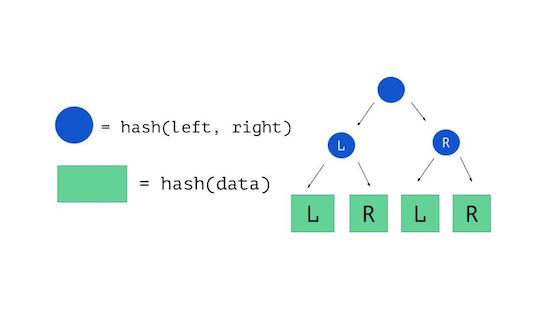
The leaf nodes in a Merkle tree store hashes of data, and parent nodes are calculated by concatenating their children and then applying the hash function to that result.
Root Hash
The root node in a Merkle tree is called a root hash, and as we'll see in a moment, it plays an important role in peer-to-peer systems.
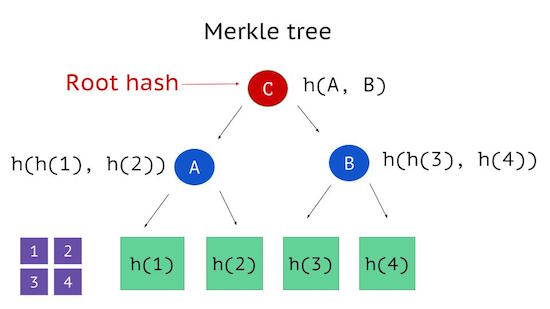
Examples
Checking for Equality
Let's look at an example where we have two datasets, each represented by a Merkle tree, and we want compare the trees to see if they're equal.
Right away, you can see that the root hashes are different, and maybe you can see why.
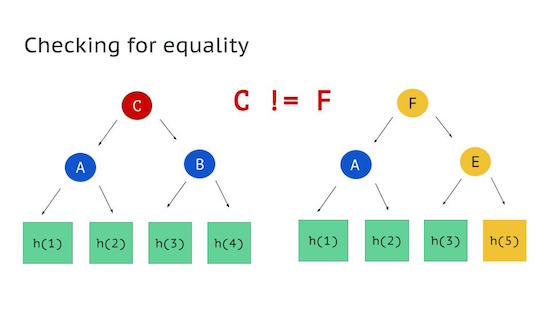
If you think about how a Merkle tree is constructed, because each node is dependent on its child's value, any change in the dataset bubbles up all the way to the root hash. So the only thing you need to consider when comparing two Merkle trees is the root hash.
This is great! Not only does it reduce the number of comparisons required to determine inequality, but if we're doing the comparison across a network, then the only thing you need to send over the network is the root hash (typically 32 bytes in size).
How Is It useful?
In peer-to-peer protocols, the root hash serves as an address for a set of files, not much unlike a Web address. If you have the link, you can download the files that it addresses. And just like on the traditional Web, we need to apply a similar level of caution to who we trust links from. We don't click on links in our email from unknown senders, because they could contain malware.
In peer-to-peer protocols, it's important to get the root hash from someone we trust. In this example, the root hash is C. Once we have the root hash, we can start asking peers on the network to send us the files that correspond to the root hash C.
Once we have all of the data, in this case 1, 2, 3, and 4, we can reconstruct the tree in order to confirm that the root hash we calculate is the same as the root hash we got from someone we trust.
In this example, we see that the two root hashes are the same, so we know with 100% certainty that the chunks of data haven't been accidentally corrupted or intentionally tampered with. Because if they were, we would have calculated an entirely different root hash.
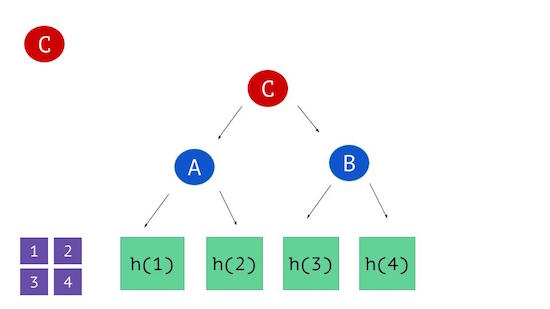
But Wait...
If the root hash allows us to efficiently compare two datasets, why even bother constructing a tree? Couldn't we just concatenate all the chunks of data then apply the hash function that result? That could fulfill the same purpose, but it turns out there's some extra utility afforded by constructing a tree.
Partial Verification
In the last example, we needed to download all of the chunks of data before we were able to do any verification over it. But what if we only want one file from a dataset? Wouldn't it be convenient if we could verify data as we receive it?
We can do exactly that. In this example, again, we'll get a root hash from a trusted peer, and start asking peers on the network to send us the data that it addresses.
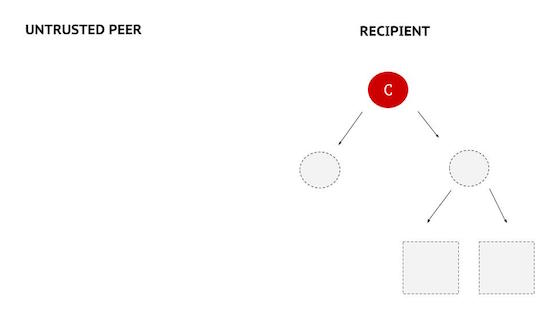
Once we get the first piece of data, we need to verify its integrity. Let's ask ourselves: if we have the root hash and one chunk of data, what other information do we need in order to verify the integrity?
It turns out it's not very much data at all!
We have 4, so we can calculate the h(4):
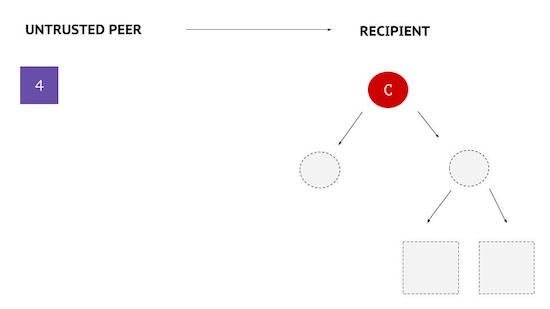
We'll need h(3) so that we can determine B:
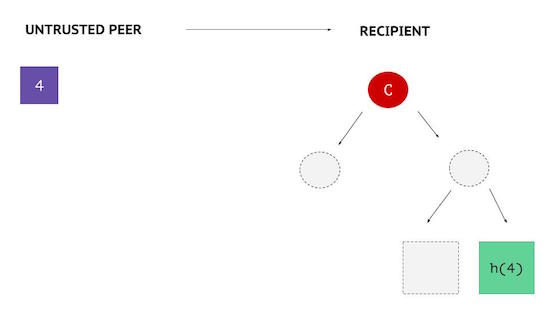
And finally we need A, so that we can calculate the root hash C:
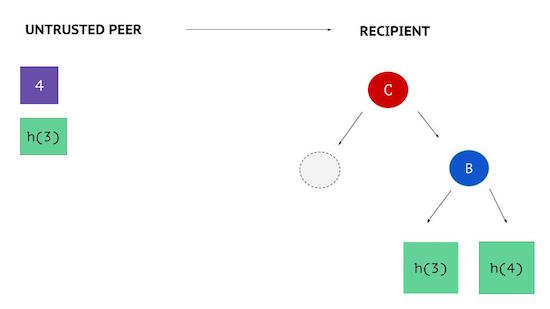
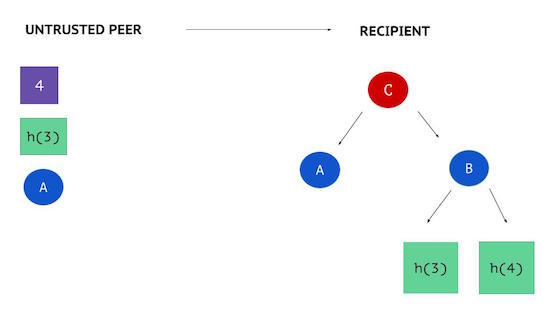
Once we have that data, we know with 100% certainty that 4 does indeed belong in this dataset.
It's important to notice that the only thing that needed to be sent from a trusted party was the root hash. The data and the proof required to verify the data all came from an untrusted peer, which is a critical part of making it possible to distribute the cost of contributing bandwidth across a network of peers.
Conclusion
Merkle trees are used in dozens of projects, and actually have some other cool properties that I'll save for another time. But they're of critical importance for decentralized and peer-to-peer technologies. Addressing content with a root hash provides consistent links that stay the same no matter where content is hosted, and being able to efficiently verify data makes across a network makes it possible to distribute the responsibility of contributing bandwidth and disk space.
In summary, Merkle trees enable a Web built on small contributions of many rather than the concentrated resources of a few.